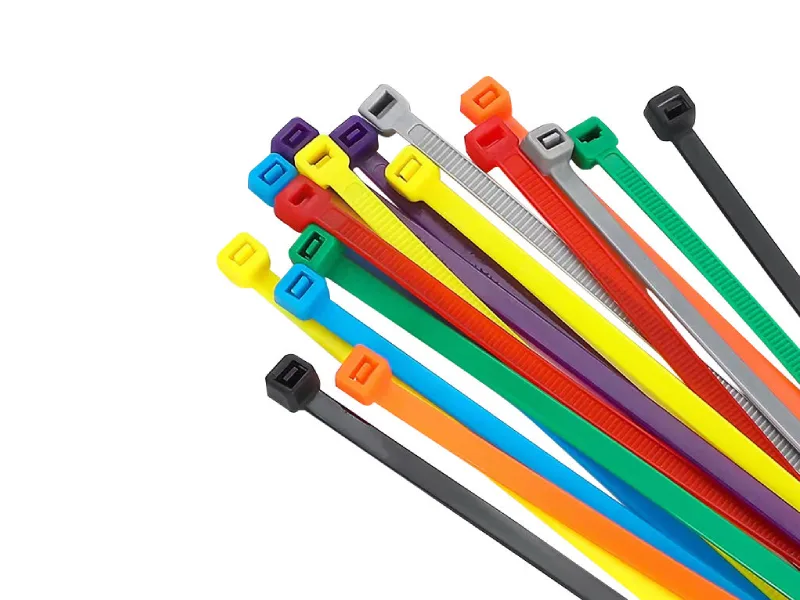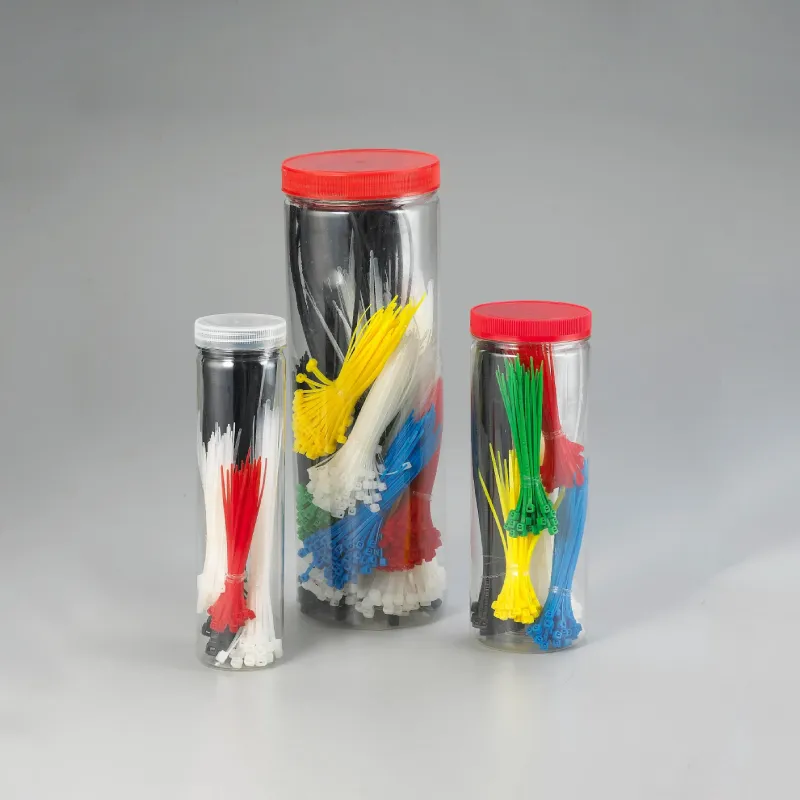The $500 Lesson in Cable Tie Quality
Picture this: You’re three months into a major outdoor substation upgrade. The project is running smoothly until a routine inspection reveals a disaster—dozens of cable ties securing critical control wiring have become brittle, cracked, and failed. Loose cables are now rubbing against sharp edges, creating potential short circuits and safety hazards. The maintenance manager is furious. The replacement cost? Over $500 in labor alone, not counting the emergency overtime and the risk of unplanned downtime.
The culprit? Cheap cable ties that looked identical to premium ones during procurement.
This scenario plays out in facilities worldwide every single day. The cable tie market is flooded with products that appear nearly identical on a supplier’s website, but the performance gap between budget and premium ties is vast—often the difference between a 3-month failure and a 10-year service life.
Why “Good Enough” Cable Ties Aren’t Good Enough
The problem isn’t just about price. It’s about knowing what you’re looking at. Most purchasing decisions are made based on dimensions and tensile strength ratings printed on a datasheet. But here’s the harsh reality: a 50 lb-rated tie from a low-quality manufacturer might fail at 30 lbs in real-world conditions, while a premium 50 lb tie exceeds its rating consistently.
The root causes of cable tie failures include:
- Substandard raw materials (recycled or impure nylon that degrades rapidly)
- Poor manufacturing controls (inconsistent molding temperatures, inadequate curing)
- Missing UV stabilizers (causing outdoor ties to become brittle within weeks)
- No batch testing (meaning defective lots reach your facility unchecked)
Traditional selection methods—choosing the cheapest option that “meets the spec”—fail because they assume all manufacturers are honest and all specifications are tested. They’re not.
The Four-Step Quality Recognition System
The good news? You don’t need a materials lab to identify premium cable ties. By following this systematic inspection method, you can separate exceptional products from industrial junk before they ever reach your installation—and avoid that $500 lesson.
Step 1: Visual Inspection – Manufacturing Precision Reveals Everything
Before you even think about tensile strength ratings, examine the tie’s surface under normal lighting. This 30-second inspection tells you more about manufacturing quality than any marketing brochure.
Nelere dikkat etmelisiniz:
Surface Quality – A premium cable tie should have a smooth, glossy finish that’s uniform across the entire length. Run your finger along the body and strap. You should feel no roughness, bumps, or texture variations.
Red flags that indicate poor manufacturing:
- Air bubbles or voids – These are structural weak points that will concentrate stress and cause premature failure
- Surface cracks or crazing – Signs of improper cooling during molding or degraded material
- Flashing (excess plastic along edges) – Indicates worn molds or poor quality control
- Discoloration or cloudiness – Suggests moisture contamination or recycled materials
Dimensional consistency – Using calipers, measure the width at multiple points along the tie. Premium manufacturers hold tolerances to ±0.1mm. If you see variations exceeding 0.2mm, you’re looking at a quality control problem that will affect the lock’s grip and the tie’s rated strength.
🔧 Pro-Tip: The surface tells the story—air bubbles, cracks, or flashing aren’t just cosmetic issues; they’re red flags of compromised structural integrity that will fail under load.
Locking Mechanism Inspection – This is where cheap ties reveal themselves. Examine the locking pawl (the mechanism inside the head) and the teeth along the strap:
- Teeth should be uniform, sharp, and precisely formed – no rounded edges or deformations
- The pawl should move smoothly but with firm spring tension – too loose means weak retention; too stiff suggests material brittleness
- Insert the strap and apply moderate tension – A quality lock grips immediately and firmly without the strap slipping back
Step 2: Material Verification – Understanding What You’re Actually Buying
This is where the engineering rubber meets the road. Not all nylon is created equal, and the material grade determines whether your tie survives one season or ten.
Nylon 6/6: The Industry Gold Standard
The vast majority of high-quality cable ties are manufactured from Naylon 6/6 (also written as PA66 or Polyamide 66). This isn’t marketing jargon—it’s a specific polymer with documented properties:
- Çekme mukavemeti: 70-85 MPa (virgin material)
- Çalışma sıcaklığı: -40°C to +85°C continuous
- Chemical resistance: Excellent against oils, greases, most solvents
- Moisture absorption: 2.5-3%, which provides flexibility without sacrificing strength
🔧 Pro-Tip: Nylon 6/6 isn’t just marketing jargon—it’s the difference between a tie that lasts 3 months outdoors versus one that survives 3+ years of UV exposure.
How to verify material grade:
- Check the manufacturer’s datasheet – Reputable suppliers explicitly state “Nylon 6/6” or “PA66.” Vague terms like “nylon material” or “high-strength polymer” are red flags.
- Request material certifications – Quality manufacturers provide material test reports showing polymer grade, tensile strength, and additive content.
- Burn test (for sample verification) – Nylon 6/6 burns slowly with a blue flame base and smells like burning plastic or wool. It self-extinguishes quickly when the flame source is removed. This isn’t practical for large orders, but confirms samples before bulk purchase.
Specialized Materials for Demanding Environments:
- UV-resistant Nylon 6/6 – Contains carbon black or UV stabilizers; appears black or dark gray. Essential for outdoor installations. Standard nylon without UV treatment becomes brittle and fails within 6-12 months of sun exposure.
- Nylon 12 – Lower moisture absorption (0.5%), better dimensional stability, superior cold-temperature performance (-60°C). Use for precision applications or extreme cold environments.
- Stainless Steel (304/316) – For extreme chemical exposure (acids, strong alkalis) or temperatures exceeding 150°C. Offers 2-3x the tensile strength of nylon but zero flexibility. Common in food processing, marine, and chemical plants.
Material red flags:
- Recycled or reclaimed nylon – Significantly weaker and less consistent (often 40-60% of virgin material strength)
- Mystery polymers – If the supplier can’t or won’t identify the specific material grade, assume it’s substandard
- Unusually cheap pricing – Virgin Nylon 6/6 has a known commodity cost; if the tie price is 50% below market average, the material quality is compromised
Step 3: Mechanical Testing – Tensile Strength and Breaking Behavior
Here’s a critical truth that most engineers don’t realize: The rated tensile strength number matters less than how the tie breaks.
A quality cable tie should exhibit predictable mechanical behavior:
Proper breaking characteristics:
- The tie should stretch slightly under load (3-5% elongation) before reaching breaking point
- Failure should occur cleanly across the strap at or slightly above the rated tensile strength
- The break should be sudden and complete – not a slow tear or delamination
Warning signs of poor quality:
- Premature failure at the lock – Indicates weak pawl design or poor tooth engagement
- Breaking significantly below rated strength – Quality manufacturers test every batch; consistent underperformance means no real testing occurs
- Brittle fracture with no elongation – Suggests degraded material, excessive moisture loss, or recycled content
- Delamination or splitting along the length – Reveals poor material mixing or contamination
Field testing method:
For critical applications, perform sample testing before large purchases:
- Select 10 random ties from the batch
- Install each on a test rig (or around a fixed post) and pull with a calibrated spring scale or tensile tester
- Record the breaking force and observe the failure mode
- Calculate the average and standard deviation – Premium ties show < 10% variation between samples; budget ties often exceed 25% variation
🔧 Pro-Tip: A quality cable tie should break cleanly at its rated tensile strength, not prematurely at the lock or along the body—this is your litmus test for manufacturing precision.
Additional mechanical checks:
- Flexibility test – Bend the tie into a U-shape. It should flex smoothly without cracking or whitening (stress marks). Release it—quality ties return nearly to their original shape.
- Sıcaklık döngüsü (for outdoor use) – Place sample ties in a freezer (-20°C) for 4 hours, then in an oven at 80°C for 4 hours. Repeat 3 cycles. UV-resistant quality ties show minimal change; poor ties become brittle or permanently deformed.
Step 4: Standards Compliance and Certifications – Your Insurance Policy
This is where many facilities make a critical mistake: treating certifications as “nice to have” rather than “must have.” In reality, proper certifications are your best guarantee that what’s printed on the package matches what’s inside.
Essential certifications for quality cable ties:
- UL 62275 / IEC 62275 – These are the global standards specifically for cable ties and cable management products. They test:
- Tensile strength under standard conditions
- Resistance to abnormal heat and fire
- Retention force over time and temperature cycles
- Material flammability ratings
- A UL-listed cable tie isn’t just compliant—it’s been independently verified by a third-party testing lab. This certification costs manufacturers significant money to obtain and maintain, which is why budget suppliers skip it.
- RoHS (Tehlikeli Maddelerin Kısıtlanması) – Confirms the tie is free from lead, mercury, cadmium, and other toxic substances. Essential for:
- Electronics manufacturing and assembly
- Export to EU markets
- Environmental and worker safety compliance
- MIL-SPEC Ratings – For military, aerospace, or defense applications:
- MIL-STD-202 (environmental testing)
- MIL-DTL-23190 (military-grade cable ties)
- ISO 9001 Certification (Manufacturer Level) – While not specific to the product, ISO 9001-certified manufacturers have documented quality management systems, batch traceability, and consistent testing protocols.
🔧 Pro-Tip: Certifications like UL 62275 aren’t optional paperwork—they’re your insurance policy against field failures and liability issues.
How to verify certifications:
- Request certification documents – Genuine manufacturers provide cert copies immediately
- Verify UL certification online – Search the UL Product iQ database (productiq.ul.com) using the manufacturer’s name or file number
- Look for markings on the tie itself – UL-listed ties often include “UL” or the UL symbol molded into the head along with the file number
- Ask for batch test reports – Quality manufacturers test tensile strength, dimensions, and material properties for every production batch (typically 10,000-50,000 units) and can provide these reports
Quality Recognition at a Glance: Your Inspection Checklist
| Inspection Category | Premium Quality Indicators | Red Flags |
|---|---|---|
| Surface Finish | Smooth, glossy, uniform | Air bubbles, cracks, flashing, roughness |
| Boyutlar | ±0.1mm tolerance, consistent width | Variations >0.2mm, inconsistent measurements |
| Malzeme | Virgin Nylon 6/6 or specialized grade | “Nylon material” (unspecified), suspiciously cheap |
| Lock Mechanism | Precise teeth, firm pawl, immediate grip | Rounded teeth, loose pawl, strap slippage |
| Çekme Dayanımı | Meets or exceeds rating with clean break | Breaks at lock, fails below rating, high variation |
| Sertifikalar | UL 62275, IEC 62275, RoHS documented | No certifications or unverifiable claims |
| UV Dayanımı | Carbon black visible, explicit UV rating | Claims outdoor use without UV certification |
The Bottom Line: Quality Costs Less Than Failure
Here’s the economic reality that purchasing managers need to understand: A premium cable tie might cost 2-3 times more than a budget option, but it eliminates the 10x cost of failure.
When you factor in:
- Labor costs for re-installation ($40-80/hour)
- Emergency service calls and overtime premiums
- Potential equipment damage from loose cables
- Safety incidents and OSHA violations
- Inventory and logistics for rushed replacements
The true cost of a failed $0.15 cable tie can easily exceed $50-100.
Premium cable ties from manufacturers who invest in quality materials, precise manufacturing, rigorous testing, and proper certifications deliver:
- ✅ 10+ year service life in rated conditions
- ✅ Consistent performance across every tie in every batch
- ✅ Reduced maintenance and replacement cycles
- ✅ Eliminated safety risks from unexpected failures
- ✅ Compliance confidence with documented certifications
Your Next Step: Apply This Knowledge
Now that you have this four-step recognition system, you’re equipped to make informed cable tie selections that protect your facility, your budget, and your reputation. Whether you’re procuring for a new installation or qualifying a new supplier, spend 15 minutes performing these inspections before signing any purchase order.
The investment in verification today prevents the expensive emergency tomorrow.
🔧 Ready to upgrade your cable management reliability? Request sample ties from your current and prospective suppliers. Apply this inspection protocol. Compare the results. The difference will be immediately apparent—and your facilities team will thank you for years to come.
Need technical guidance on selecting the right cable tie specifications for your specific application? Contact your electrical distributor’s technical support team or consult with certified cable management specialists who can recommend the optimal product for your environment, load requirements, and service life expectations.
Hatırlamak: In the world of cable ties, you truly get what you inspect—not just what you pay for.





